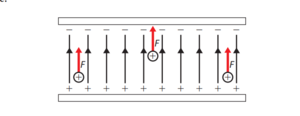Electric field
MEDICAL APPLICATIONS WEAK - MORE ELECTROMAGNETIC AND ELECTRIC IMPULSE STIMULATION THAN ELECTRIC FIELD
Electric Field[edit | edit source]
Introduction[edit | edit source]
Electric field can be defined as a space or region where a charged object experiences a force due to its charge. THE ELECTRIC FIELD AT A POINT IN SPACED IS DEFINED QUANTITATIVELY AS THE FORCE ON A UNIT POSITIVE TEST CHARGE AT THAT POINT IN THE FIELD.
Field line[edit | edit source]
These are imaginary lines either straight or curved with property that the tangent of a field line at a certain point gives the direction of the electric field. Every single positive charge radiates electric field lines that comes out of the charge. In case of a negative charge the field lines are directed towards the charge (opposite direction to the positive one).
Couloumb’s Law[edit | edit source]
The force between TWO SMALL CHARGES CAN BE CALCULATED USING Coulomb’s law. It states that, the force experienced by two point charges is directly proportional to PRODUCT OF THE CHARGES AND INVERSELY PROPORTIONAL TO the INVERSE square of THE DISTANCE BETWEEN THEM. Hence,
Whereby, F is force, and are charges, r is the distance between the charges and is constant which is equal to 9x10⁹Nm²C⁻²
Electric Field Strength (E)[edit | edit source]
The space around a charge is different from a space with no charge present. This can be tested by bringing a small positive charge q into the provided space. In case, the charge q experiences some type of force then there is electric field, if not, there is no electric field (or it is zero).
As indicated in the formula electric field is a vector quantity. The direction is that of the force of a positive charge would experience at the given point. The unit of electric field can be derived from the given formula which is N⋅C−1. The concept of electric field enables us to understand how force can transfer from one charge to another.
Application of electric fields in medicine[edit | edit source]
- Alternating electric field therapy - this is a type electromagnetic field therapy with low-intensity electric fields which can disrupt the division of cancer cells and slow the growth of brain tumors. Laboratory experiments and a small human trial by Yoram Palti MD, Ph.D [1], raises hopes that electric fields will become a new weapon for stopping the progression of cancer. These devices generate waves between 100-300 kHz e.g.TTF device has been approved by the U.S. and Europe for the treatment of recurrent glioblastoma. However, these treatments have side effects like killing of healthy cells, skin rashes caused by electrodes, severe nausea etc.
- Muscle stimulation - electric field is usally used to relieve pain. Electrical field is created in biological tissues to stimulate or alter healing process. Electric field is created on the skin surface to drive ions beneficial to the healing process into or through the skin. The effects of these are at cellular level e.g. excitation of nerves, changes in the cell membrane permeabilty etc.
Conclusion[edit | edit source]
In Summary electric field is a vital field in modern medicine and in future as well. Like in any other field of medicine there are health effects associated in usage in electric field. According to WHO it is not possible to determine whether there are longterm consenquences even from exposure at minimal range because, to date, there are no well-conducted epidemiological or long-term animal studies. However, it is up to to the patients and medical personell to determine if the benefits outweigh the risks to using such devices. Otherwise as more research is done the future seems to be promising in medical field.
Links[edit | edit source]
- Carl R. Nave, Department of Physics and Astronomy Electric field in "Electricity and Magnetism", R Nave – Hyperphysics, Georgia State University
- Fields – a chapter from an online textbook
- Bill Doyle, TEDtalk, Treating cancer with electric fields
References[edit | edit source]
- ↑ Chris Hamper,(2008), IB Higher Level Physics Pearson Baccalaraute ISBN-13: 978-0435994426
- ↑ http://hyperphysics.phy-astr.gsu.edu/hbase/electric/elefie.html
- ↑ http://www.regentsprep.org/Regents/physics/phys03/afieldint/default.htm
- ↑ Treating cancer with electric fields
- ↑ http://www.medgadget.com/2007/08/treating_cancer_with_electric_fields.html










